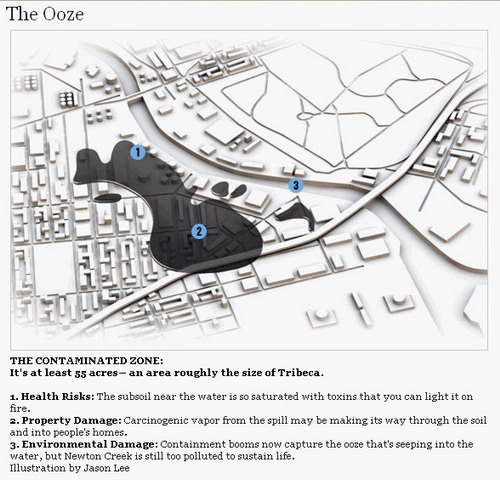Greenpoint Oil Spill: A Traveling Blob the Size of Tribeca

One of the truisms of life in Brooklyn is that every few months, one can look forward to another long and detailed story about the large and nasty Exxon/Mobil Oil Spill in Greenpoint. So it is with the new New York Magazine, which contains a long, detailed and engaging story about North Brooklyn's 17-30 million gallon underground oil horror. What we like most about the New York article isn't all the research and detail, it's the excellent way in which the spill is described. For instance:
To see the extent of the problem, imagine a viscous tar-colored blob stretching amoebalike through the Earth. It starts where Meeker Avenue hits Newtown Creek, seeping out into the waterway. From there it extends south and steadily deeper under the Brooklyn soil, reaching a depth of about 40 feet. It’s contained from below by the groundwater in the Brooklyn-Queens aquifer: The oil is repelled by the water, so the muck “floats” on top. Like the Blob in the eponymous Steve McQueen movie, it keeps changing shape and moving—bulging south beyond the Brooklyn-Queens Expressway, slithering north toward Greenpoint Avenue, ballooning west to at least Monitor Street. This black lagoon fills the nooks and crannies in the gravel, sand, and silt that characterize the soil of the area, pooling in pockets that range from just centimeters thick to natural vats that are 25 feet deep. The contaminated zone encompasses at least 55 acres of northern Brooklyn—an area roughly the size of Tribeca.The article delves into the history of the spill, the public sector's lack of action and the debate about whether the oil spill has led to higher cancer rates in the parts of Greenpoint beneath which it lurks (fortunately, the bulk is beneath industrial sections, but it is believed to be encroaching further into residential areas beyond the points at which it is known to be). Definitely make it your fun long reading of the week.
Labels: Environment, Greenpoint Oil Spill

4 Comments:
New York Magazine has lies in the article that cannot be disputed and can only be called scare tactics. The cancer victim never lived in Greenpoint. In fact he lived on Devoe Street in Williamsburg where there were three other cancer victims on the same block (one in his own apartment after he moved). There are NO cancer clusters in Greenpoint. Tom Stagg does NOT live above an oil spill. Tom Stagg changes his story every time he is quoted. The vapor study recently conducted by the NYS Dept. of Health showed NO vapors in the community from the underground oil. Scare tactics are exactly what this story is all about. CB1, the Borough President, GWAPP and NAG were furious that they did not get the mandatory 40% affordable housing component they were lobbying for attached to the rezoning of the Greenpoint's waterfront. Since the rezoning, this scare campaign about Greenpoint has started. Hoffman and Holowicz are members of the affordable housing groups and when affordable housing is proposed in Williamsburg there is always an excuse for why it shouldn't be built there. When Toll Brothers' 29 story luxury condo was proposed, NAG, Waterfront Preservation Alliance, CB1 and the rest were silent. No request for the additional 10% affordable units was lobbied for by these supposed advocates when it is on the Williamsburg waterfront. Now when the developers of the Domino Suger site proposed 50% affordable housing and landmarking one of the oldest refinery buildings, the outcry has now been to landmark the entire complex knowing full well that it will limit the percentage of affordable units because the project would become economically unfeasible to build. Instead of attacking commenter #1, how about attacking the authors of the clearly false article being published over the past year.
Anonymous: Environmental justice and human life are far more important than your Greenpoint property value.
Greenpoint property values are through the roof. This scare campaign will fail just like all the scare campaigns in the past have. If there is anybody selling a building, I'm buying.
It does seem odd that the most vocal people who claim health problems in their neighborhoods do not actually live over the spill or near the spill. The spill is a big problem that needs to be clean-up, but the neighborhood's self-appointed spokespeople don't live in the neighborhood and claim that the spill is the source of all ills in the area. They may be missing other problems that are literally closer to home. If you have suspicions about specific places that might be a problem, let someone know about them.
Post a Comment
<< Home